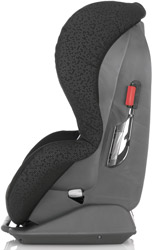Forward-facing Seats

Once children have outgrown a rearward-facing baby seat, they can use an extended rearward facing seat, which will allow them to continue travelling rearward facing until they reach 18kg or 25kg. They can also use a group 1 forward-facing child seat with an internal harness. Children using these seats are much less likely to be injured in a crash than children who are using seat belts on their own, or even worse, are completely unrestrained.
Forward-facing child seats provide impact protection, and an integral five point (or three point) harness or an impact shield to hold the child in place.
Seats with a Harness
The straps help to spread the force of a crash over a wide area of their chest and pelvis and keep the shoulder straps on the child's shoulders.
Take time to get your child comfortably strapped in and to make sure the harness is correctly adjusted. The top of the harness should be about 2cm above your child's shoulder. It should be quite tight, so that only one or two fingers can fit between the child's chest and the harness. The harness buckle should not rest over the child's tummy. Clothing can affect how snugly the harness fits, so check it every journey.

Many seats have an adjustable back which can be raised or lowered to suit the height of the child using it, and allows the height of the harness to be adjusted without having to unthread it from the seat. Others have slots in the back to adjust the height of the harness; you have to take it out of one set of slots and thread it through another set.
Seats with an Impact Cushion/Shield
Some seats have an impact shield or cushion, which is held in place by the car's three point seat belt, instead of an internal harness. These seats also usually have an adjustable back or headrest which can be raised or lowered to suit the height of the child using it, according to the manufacturer's instructions.
Forward-facing child seats can be used in the front or rear of the car, but it is safer to put them in the rear, especially if there is a passenger airbag in the front.
It is safest to keep children in this type of seat until they have outgrown it. Only move your child to a booster seat once they have exceeded the maximum weight for the forward-facing child seat, or when the manufacturer's advice recommends that they are too tall for the seat (usually this will be when the top of the seat is below the eye level of the child).
Types of forward-facing child restraints


Group 1: for toddlers weighing 9-18 kg (20-40 lbs) roughly from 9 months - 4 years.
The internal harness keeps the child in the seat if there is a crash, and spreads the force of the impact. Side impact wings also provide protection to the child's head and body. The harness can be adjusted as the child grows.
Group 1, 2 & 3 for toddlers and children from 9 to 36 kg (20 - 79lbs), roughly from 9 months to 12 years
Group 1, 2 and 3 seats are forward-facing. The child uses the seat's integral harness until they are 15 kg and then uses the car's seat belt, which secures the child and the seat. They last longer because they can be adjusted as your child grows.

Fitting forward-facing seats
As with all child car restraints, follow the manufacturer's recommendations on how to fit and use them, or visit our Child Car Seat Fitting and Compatibility page to access manufacturer video guides on how to fit your child car seat.
Depending on the type of seat, it will be fitted with the car's seat belts or if it is an Isofix or i-size seat, it will fit into the Isofix anchorage points that are built into the car.
Seat fitted with the car's seat belts
Forward-facing seats that are fitted with the car's seat belts and adhere to R44 regulations have red guides through which the seat belt must be threaded to secure the seat. The seat belt is threaded through the red guides on the child seat. The correct way to fit it will be shown on labels on the side of the seat.
If your seat adheres to the new i-Size (R129) regulation, it will have green seatbelt guides through which the seat belt must be threaded to secure the seat. The correct way to fit it will be shown on labels on the side of the seat.
Isofix forward-facing seats

Forward-facing Isofix seats do not use the car's seat belts. They have mounts built into them that slot into the Isofix anchorage points that are built into the car. They will also have either a support foot that needs to be extended to the floor of the car or a top tether that fixes to the top tether points behind the car seat.
Check whether your Isofix child seat is approved for your car by contacting your car manufacturer and/or the child seat manufacturer; many have a list on their website that shows which seats are approved for which cars.

Forward-facing seats with bases
Some seats have a separate base that is fitted with the car's seat belt and/or into the Isofix points, and the seat just clicks into the correct position on the base. The base can be left permanently in the car, which makes putting the seat in and taking it out of the car quicker and easier. If the base is fitted with the car's seat belts, thread the seat belt through the red or green guides (not the blue ones).
Photos courtesy of Britax and RECARO Child Safety Ltd
